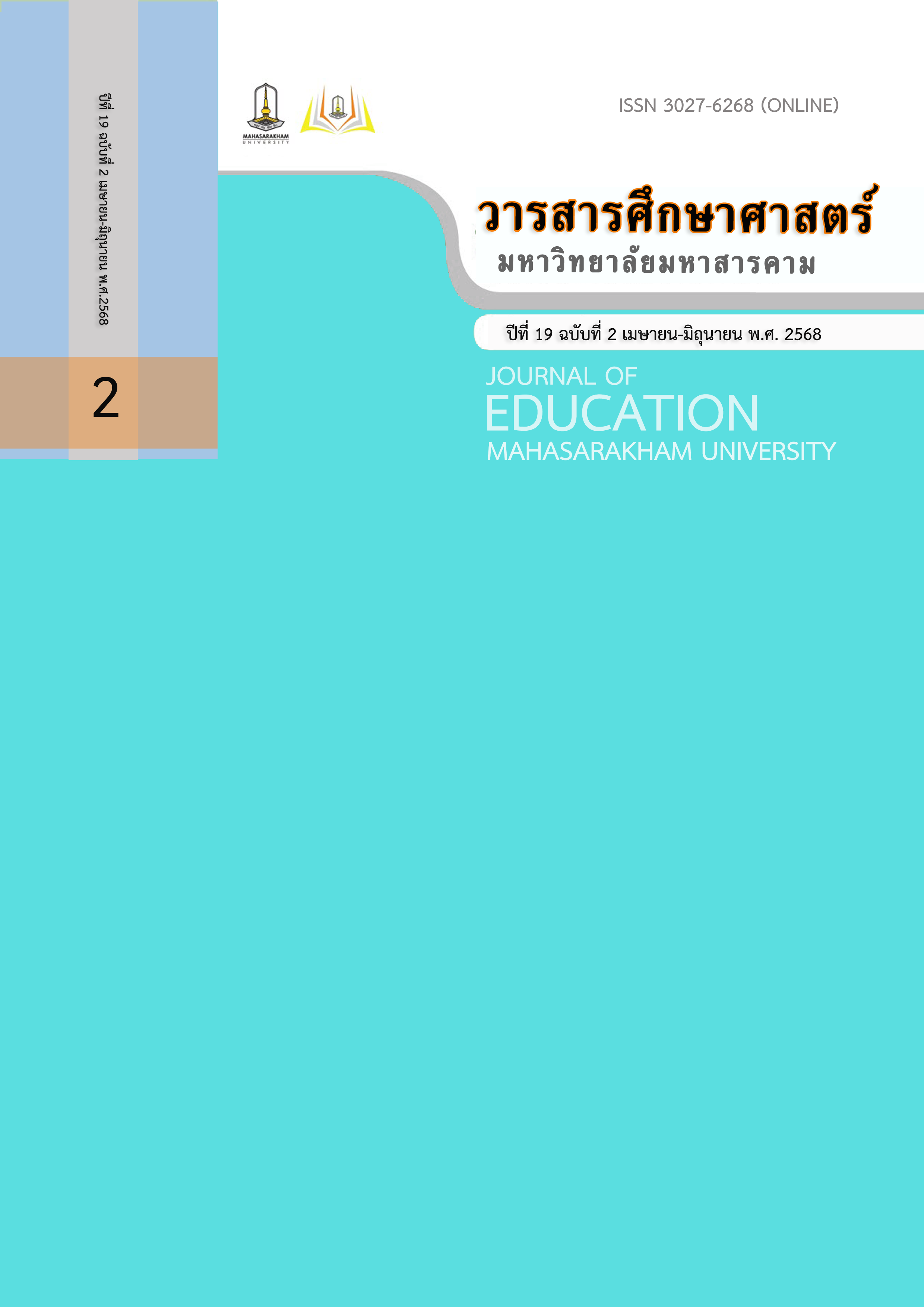The Development of Activities Based on 5E Inquiry Cycle with Concept Mapping to Enhance the Scientific Reasoning Ability on the Topic of Atoms and Properties of Elements of Grade 10 Students
Main Article Content
Abstract
The purposes of this research were 1) to develop activities based on the 5E inquiry cycle with concept mapping to enhance the scientific reasoning ability and 2) to compare the scientific reasoning ability of Grade 10 students through the 5E inquiry cycle with concept mapping during the pre-test and post-test. The samples were 40 grade 10 students at Sarakhampittayakhom School. The samples were selected using the cluster random sampling technique. The research instruments included 1) the 9 lesson plans of the 5E inquiry cycle with concept mapping on atoms and properties of elements in chemistry and 2) the scientific reasoning test of atoms and properties of elements. Statistics used in this research consist of mean, standard deviation, percentage, and dependent t-test.
The results of the study were as follows: 1) Effects of development activities based on the 5E inquiry cycle with concept mapping showed that students who learned through the 5E inquiry cycle with concept mapping had enhanced the ability to conclude and also checked the issue about the ability to explore situations or problems and the ability to predict the answer in the Explore stage and Explain stage. Evaluation of the lesson plans from educationists found that the learning plans were suitable for learning (= 4.44, SD=0.27). and 2) Grade 10 students had scientific reasoning ability post-test higher than pre-test criteria with the statistically significant of .01 level.
Downloads
Article Details

This work is licensed under a Creative Commons Attribution-NonCommercial-NoDerivatives 4.0 International License.
References
กุลิสรา จิตรชญาวณิช และเกศราพรรณ พันธุ์ศรีเกตุ คงเจริญ. (2563). วิธีการจัดการเรียนรู้ในศตวรรษที่ 21. กรุงเทพฯ: สำนักพิมพ์จุฬาลงกรณ์มหาวิทยาลัย.
งานประกันคุณภาพการศึกษา โรงเรียนสารคามพิทยาคม. (11 มิถุนายน 2565). รายงานประเมิน ตนเองของสถานศึกษา (Self-Assessment Report : SAR) ปีการศึกษา 2565. โรงเรียนสารคามพิทยาคม. สืบค้นเมื่อ 11 กรกฎาคม 2566, จาก https://drive.google.com/file/d/1bftD6uEIv-VJT7JhlPXIqMoRu6aZrZWm/view
จุนจุฬา ทิพย์พิมานพร. (2565). การจัดการเรียนรู้แบบสืบเสาะที่ขับเคลื่อนด้วยกลวิธีการโต้แย้งที่มีผลต่อความสามารถในการให้เหตุผลเชิงวิทยาศาสตร์และเจตคติต่อวิทยาศาสตร์ของนักเรียนชั้นมัธยมศึกษาปีที่ 5. วารสาร เทคโนโลยีและสื่อสารการศึกษา คณะศึกษาศาสตร์ มหาวิทยาลัยมหาสารคาม, 5(16), 32-42.
ณัฏฐ์ฏาพร พิชญภูสิทธิ. (2563). การวิจัยเชิงปฏิบัติการเพื่อพัฒนาความสามารถในการให้เหตุผลเชิงวิทยาศาสตร์ โดยการจัดการเรียนรู้ด้วยรูปแบบการสืบสอบแบบแนะแนวทาง เรื่องกรด-เบส สำหรับนักเรียนชั้นมัธยมศึกษาปีที่ 5. วารสารวิชาการและวิจัยสังคมศาสตร์, 15(2), 101-116.
ทิศนา แขมมณี. (2562). ศาสตร์การสอน (พิมพ์ครั้งที่ 23). กรุงเทพฯ: ศูนย์หนังสือจุฬาลงกรณ์ มหาวิทยาลัย.
ทศพล ทับอาษา. (2566). ผลการจัดการเรียนรู้แบบผสมผสาน (Blended learning) ร่วมกับการจัดการเรียนรู้แบบสืบเสาะหาความรู้ (5Es) ประกอบผังมโนทัศน์ หน่วยการเรียนรู้ งานและพลังงานของนักเรียนชั้นมัธยมศึกษาปีที่ 4. วารสาร มจร อุบลปริทรรศน์, 8(3), 1607-1616.
พิมพันธ์ เดชะคุปต์. (2544). การเรียนการสอนที่เน้นผู้เรียนเป็นสำคัญ: แนวคิดวิธีและเทคนิคการสอน 1. กรุงเทพฯ: เดอะมาสเตอร์กรุ๊ฟแมนเนจเม้นท์.
ศรัณย์ อัมระนันท์. (2558). ผลของการจัดการเรียนรู้แบบสืบเสาะหาความรู้โดยเน้นการใช้คำถามระดับสูง เรื่อง พันธะโคเวเลนต์ ที่มีต่อผลสัมฤทธิ์ทางการเรียนและการให้เหตุผลทางวิทยาศาสตร์สำหรับนักเรียนชั้น มัธยมศึกษาปีที่ 4. วารสารศึกษาศาสตร์มหาวิทยาลัยบูรพา, 26(2), 56-70.
สถาบันส่งเสริมการสอนวิทยาศาสตร์และเทคโนโลยี. (19 เมษายน 2560). สรุปผลการวิจัยโครงการ TIMSS 2015. สืบค้นเมื่อ 5 พฤษภาคม 2566, จาก
http://timssthailand.ipst.ac.th/timss/reports/2015
สิรินภา กิจเกื้อกูล. (2565). การจัดการเรียนรู้วิทยาศาสตร์. พิษณุโลก: สำนักพิมพ์มหาวิทยาลัยนเรศวร.
สุภัทรา ตันติวิทยมาศ. (2554). การพัฒนาการแก้ปัญหาอย่างมีวิจารณญาณด้วยแผนผังมโนทัศน์ของนักเรียนชั้นมัธยมศึกษาปีที่ 2. วิทยานิพนธ์ปริญญามหาบัณฑิต, จุฬาลงกรณ์มหาวิทยาลัย, กรุงเทพมหานคร. http://cuir.car.chula.ac.th/handle/123456789/21970
สุภาวดี กาญจนเกต. (2566). การพัฒนาความสามารถการให้เหตุผลเชิงวิทยาศาสตร์และเจตคติทางวิทยาศาสตร์ของนักเรียนชั้นมัธยมศึกษาปีที่ 1 ด้วยการจัดการเรียนรู้ตามแนวคิดการสืบเสาะหาความรู้แบบเมตาคอกนิชัน และการถ่ายโอนการเรียนรู้. วารสารมหาวิทยาลัยราชภัฏมหาสารคาม, 17(2), 35-45.
ริญญาทิพย์ ศิริมนตรี. (2564). การพัฒนาความสามารถในการให้เหตุผลเชิงวิทยาศาสตร์และการคิดอย่างมี วิจารณญาณของนักเรียนชั้นมัธยมศึกษาปีที่ 4 ด้วยการจัดการเรียนรู้แบบสืบเสาะที่ขับเคลื่อนด้วยกลวิธีการโต้แย้ง (ADI) ร่วมกับแผนผังมโนทัศน์. วารสารวิจัย มข. สาขามนุษยศาสตร์และสังคมศาสตร์ (ฉบับบัณฑิตศึกษา), 10(1), 108-121.
วัชรา เล่าเรียนดี. (2554). รูปแบบและกลยุทธ์การจัดการเรียนรู้เพื่อพัฒนาทักษะการคิด. (พิมพ์ครั้งที่ 8). นครปฐม: โรงพิมพ์มหาวิทยาลัยศิลปากร.
วิริยาภรณ์ ชมภูวงศ์. (2563). การพัฒนาความสามารถในการให้เหตุผลเชิงวิทยาศาสตร์ของนักเรียนชั้นมัธยมศึกษาปีที่ 5 โดยใช้วงจรการเรียนรู้แบบตั้งสมมติฐานนิรนัย. วิทยานิพนธ์ปริญญามหาบัณฑิต. มหาวิทยาลัยมหาสารคาม, มหาสารคาม.
Ausubel, D. P. (1963). The psychology of meaningful verbal learning. Grune & Stratton.
Choowong, K., & Worapun, W. (2021). The Development of Scientific Reasoning Ability on Concept of Light and Image of Grade 9 Students by Using Inquiry-Based Learning 5E with Prediction Observation and Explanation Strategy. Journal of Education and Learning, 10(5), 152-159.
Good, C. V. (1973). Dictionary of Learning (1st ed.). Mcgarw-hill.
Lawson, A.E. (2009). Basic inferences of scientific reasoning, argumentation and discovery. Science Education, 94(2), 336–364.
Zulinda, A. Z. (2020). Identifying Scientific Reasoning Skills of Science Education Students. Asian Journal of University Education (AJUE), 16(3), 275-280.


